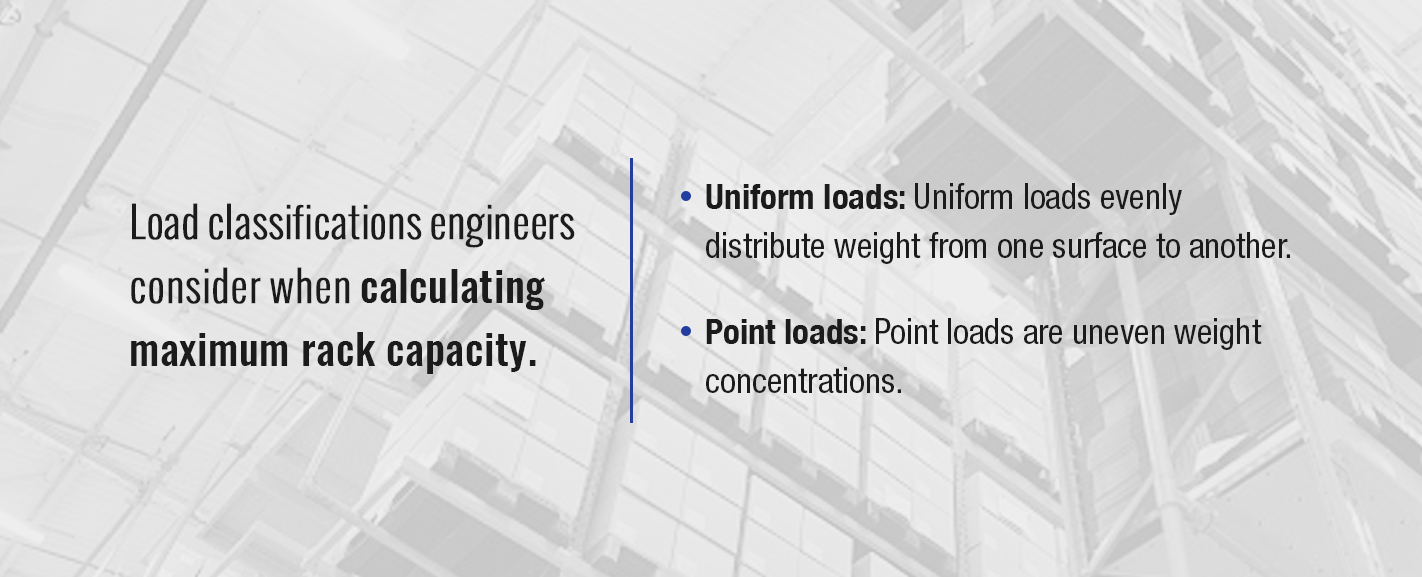How to Calculate Pallet Rack Load Capacity

-
Table of Contents
- 1. Calculating Upright Capacity
- 2. Calculating Beam Capacity
- 3. Rating Bowing or Deflection of Pallet Rack Beams
- 4. Calculating Deck Capacity
- How Much Can A Pallet Rack Hold?
In theory, figuring out how to determine rack capacity is fairly straightforward. You calculate the maximum weight of your combined pallet loads, then size your decks, beams, uprights, bracing and baseplates so they’re above and beyond that anticipated limit. Sizing rack components always aims for a level beyond any practical possibility that you’ll ever exceed your rack system’s known weight capacity.
In practice, however, there’s more to this. Every rack component manufacturer and supplier freely offers designed weight limits for each piece. The trick is making sure each rack component is compatible with its adjoining partner and not a case of being the weak link.
Rack systems are predictable parts of a warehouse infrastructure. They’ve evolved over many years. There are two main governing bodies prescribing rack specifications and ensuring the industry follows safe and reliable manufacturing and assembly methods. These are the two authorities you need to know about when calculating pallet rack capacity.
- American National Standards Institute (ANSI): This nonprofit organization represents a wide range of industries and offers uniform standards for design and manufacturing. Their document ANSI-MH 16.1-2012 covers American warehouse racking weight limits and specifications that include specialized topics like pallet rack upright capacity and even teardrop pallet racking weight capacity.
- Rack Manufacturing Institute (RMI): Every reputable pallet racking system manufacturer belongs to the RMI. That includes engineers, designers and suppliers of quality rack components. The Rack Manufacturing Institute works with ANSI to ensure American warehouses install top-end systems that won’t fail, provided they’re professionally sized and installed with strict standards.
There’s no substitute for consulting with a rack system professional when you’re calculating pallet rack capacity. Even though you can find manufacturers’ maximum load ratings online or in promotional material, a rack specialist’s experience and guidance is a critical safeguard in selecting the right components to build a safe system.
Here is the four-step method rack specialists use to determine maximum loads.
1. Calculating Upright Capacity
If one component in a rack system is most critical to calculate properly, it’s your uprights. You’ll also hear uprights called frames in the racking business. These pieces support the entire system’s weight that’s collected from the loaded pallets, set upon the decks, traversed through the beams and sent earthward through the uprights.

Uprights absorb and transfer two weight classifications. Each weight type adds to the overall capacity your uprights need to support. In engineering terms, these are the two loads happening in your pallet rack system that move along your uprights.
- Dead loads: This kind of load encompasses the static weight of your rack system by itself. It includes the total gravitational pressure exerted by the unloaded decks, beams, braces and the uprights themselves. Your rack capacity has to hold itself up, but your system must also safely support your loaded pallets.
- Live loads: Your loaded pallets are a fluid commodity. Sometimes, your racks are at maximum capacity with no extra room. At other periods, you have pallets going in and out of your warehouse and off and on your racks. Loaded pallets are called live loads. Whereas your rack component weights never change, your pallet loads do, and that’s why your rack capacity rating must exceed the maximum amount of live and dead loads stressing your system.
Engineers calculate your upright capacity from the frame dimensions. That includes the height of your uprights, the depth of their design or the distance between them and the physical measurements of the legs or upright columns. Designers also calculate maximum upright capacity from the materials used to manufacture the frames. Today, most rack manufacturers use cold-formed steel as their go-to product, although some hot-rolled steel columns exist.
An example of upright weight capacity is a typical pair of Husky Invincible® 144” upright frames with columns measuring 3” x 1-5/8”. With a 42” depth, this upright component rates at a 16,700-pound capacity. A larger frame 192” tall and with 3” x 3” columns can hold 25,300 pounds. It’s a case of a larger component being able to carry a more substantial capacity.
2. Calculating Beam Capacity
The critical information you need to know about beams is there’s a strength or carrying capacity ratio between length and depth. Beam width isn’t much of a contributor to sizing rack components. Depth, however, is crucial. Why? Because of the gravitational forces acting on a loaded rack beam.
Beams experience compression, which is the downward force placed by the live load. Beams also compensate for a tension force that stretches from the load’s center or point and traverses sideways along the beam’s run and transmits the weight to its upright connection point.
When you’re sizing beam capacity, your rule of thumb is the longer your beam, the deeper it needs to be. Using the example of a Husky Invincible® 96” rack beam with a 3.5” depth, it can carry up to 4,044 pounds per pair. If you increase this eight-foot beam’s depth to 4.3”, the pair can now support 6,111 pounds. Going further, a 144” beam length’s maximum weight capacity is only 3,000 pounds, but if you increase the depth of a 144” long beam to six feet, it will now hold 7,820 pounds per pair.
Your maximum beam capacity determines what size of uprights your system requires. Calculating rack systems starts with knowing what maximum weight you anticipate your pallets to hold. Then, size your beam pairs based on the beam length or the “bay clear entry” distance. Once you know these parameters, you can match your upright frame size and weight-bearing capacity to the beams.
As you can see, beams are a mainstay in building a robust and reliable rack system that suits your individual warehouse needs. Beams need to be sufficiently strong, and they have to serve under many changing conditions. However, you can expect your racking beams to bow a little under loads, a normal state engineers call deflection.
3. Rating Bowing or Deflection of Pallet Rack Beams
Rack beam manufacturers use high-grade steel for all components, including decks, uprights, baseplates and beams. You shouldn’t experience bowing and flexing with uprights or plates, but your horizontal cross members are made to bow or deflect. This phenomenon is natural in engineering.
Rack beams deflect or bow because they’re partly elastic. That means they sag a slight bit when under compression and tension. This integral part of beam design is nothing to be alarmed about. That’s part of their intended design.
Engineers specify a standard rack beam deflection rate within an acceptable safety standard. The bow, sag or deflection rate is 0.55% of the beam’s horizontal run. Dividing the beam span by 180 gives the maximum allowable deflection.
Some rack manufacturers specify tighter deflection tolerances for certain applications. In robotic conditions like automated storage and retrieval systems, the deflect percentage is only 0.42. With automated systems, there’s less likelihood human operators will catch an overly stressed beam, and the designers err on the side of caution.
Engineers typically specify load factors and reactions to compensate for the greatest chance of stress fatigue or failure. Interestingly, the deflection rating is primarily to alert warehouse workers of load conditions and make them mindful when they spot a deflecting beam. It ensures workers know the safety limits of loading their racks and avoiding any excessive weight placed on beams or other components.
4. Calculating Deck Capacity
Pallet rack decks or platforms serve as horizontal stabilizers that evenly disperse pallet loads across the beam works and down through the uprights. Loaded pallets are usually uneven in their direct weight distribution, and properly designed decks compensate for high and low weight transfer contact. Here are two load classifications engineers consider when calculating maximum pallet rack weight capacity.

- Uniform loads: Uniform loads evenly distribute weight from one surface to another. They’re static and dispersed in equal pressure. An example is a properly loaded rack deck transferring weight consistently across a beam.
- Point loads: Point loads are uneven weight concentrations. They’re inconsistent weight transfers where one part of the contact surface has higher pressure than another. A good point load example is pallet skids that collect a pallet’s total weight and then transfers the load in highly concentrated areas across the deck or beam.
Not all warehouse racking systems use decks. Some systems place pallet edges directly on the beams or uprights. Working without decks is a clear case of point loading, and your deckless rack systems need careful weight calculations to be sturdy and safe.
How Much Weight Can a Pallet Rack Hold?
Your pallet racking system must be sufficient to support the maximum weight you’ll possibly put on it. It’s wise to extend your manufacturer’s rated capacity to one step beyond what you’ll conceivably store. Calculating rack capacity is clearly a case of being safe than sorry.
However, it’s possible to overrate your rack size and weight capability. Overkill has unnecessary costs, and there’s little return in spending too much. Oversized rack systems are also bulkier and take up valuable warehouse storage space.
The easiest way to determine how much weight your pallet system can hold is by consulting with the experts. Professionals who specialize in warehouse racking designs will know exactly what you need. A reputable and experienced rack component supplier will work with you to assess your needs. They are the best-qualified folks to calculate a safe, dependable and economical pallet racking system that serves your facility for years.
Contact T.P. Supply for All Your Pallet Racking Needs
T.P. Supply is your best partner for determining your pallet rack capacity. We’ve worked with warehouse owners, operators and managers since 1979. Since then, we’ve specified thousands of fail-safe racks for businesses across America and beyond.
Reach out to T.P. Supply today for your rack systems and other material handling equipment. Call us at (877) 302-2337 or contact us online.


